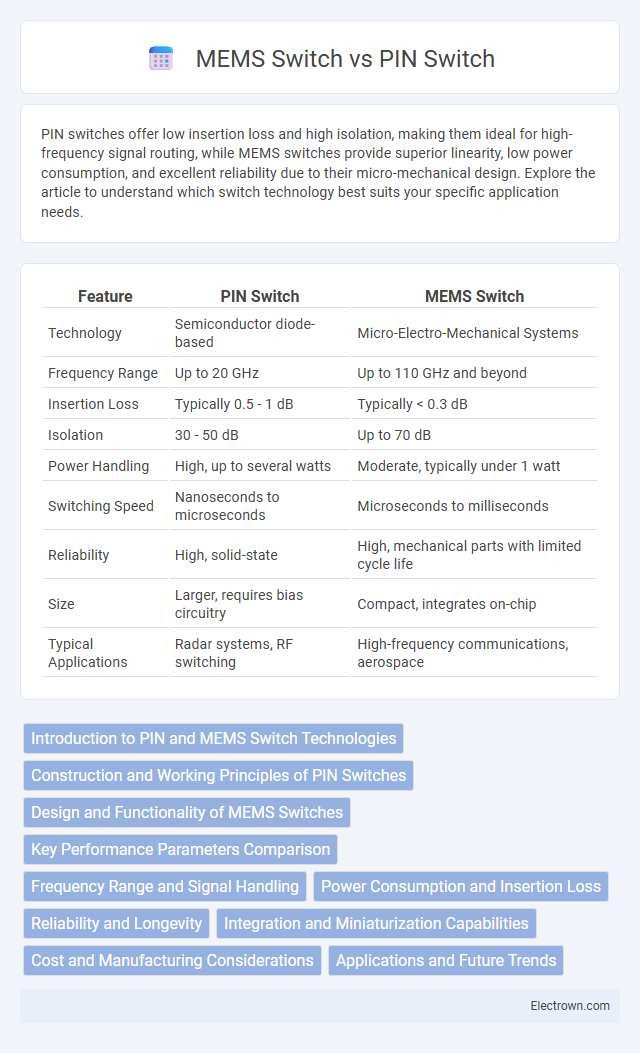PIN switches offer low insertion loss and high isolation, making them ideal for high-frequency signal routing, while MEMS switches provide superior linearity, low power consumption, and excellent reliability due to their micro-mechanical design. Explore the article to understand which switch technology best suits your specific application needs.
Table of Comparison
| Feature | PIN Switch | MEMS Switch |
|---|---|---|
| Technology | Semiconductor diode-based | Micro-Electro-Mechanical Systems |
| Frequency Range | Up to 20 GHz | Up to 110 GHz and beyond |
| Insertion Loss | Typically 0.5 - 1 dB | Typically < 0.3 dB |
| Isolation | 30 - 50 dB | Up to 70 dB |
| Power Handling | High, up to several watts | Moderate, typically under 1 watt |
| Switching Speed | Nanoseconds to microseconds | Microseconds to milliseconds |
| Reliability | High, solid-state | High, mechanical parts with limited cycle life |
| Size | Larger, requires bias circuitry | Compact, integrates on-chip |
| Typical Applications | Radar systems, RF switching | High-frequency communications, aerospace |
Introduction to PIN and MEMS Switch Technologies
PIN switches utilize semiconductor diodes with intrinsic layers to control RF signals, offering fast switching speeds and high power handling suitable for microwave applications. MEMS switches employ microelectromechanical systems to physically open or close circuits, delivering low insertion loss and high linearity ideal for sensitive RF environments. Understanding the fundamental operational differences between these technologies helps you select the optimal switch based on power requirements and signal integrity.
Construction and Working Principles of PIN Switches
PIN switches consist of a semiconductor structure with an intrinsic (I) layer sandwiched between p-type and n-type layers, allowing them to handle high frequencies efficiently. Their working principle relies on the control of carrier injection in the intrinsic region, enabling the switch to toggle between high-resistance off states and low-resistance on states quickly. You benefit from their fast switching speed and excellent isolation characteristics, making them ideal for RF and microwave applications.
Design and Functionality of MEMS Switches
MEMS switches utilize microelectromechanical systems technology, enabling precise mechanical movement at the microscale for reliable signal switching with low insertion loss and high isolation. Their design incorporates movable cantilever beams or membranes actuated electrostatically, providing faster response times and lower power consumption compared to traditional PIN switches. Your applications benefit from MEMS switches' compatibility with RF and microwave circuits, offering enhanced durability and miniaturization in advanced communication systems.
Key Performance Parameters Comparison
PIN switches exhibit low insertion loss typically around 0.5 dB and high isolation exceeding 40 dB at microwave frequencies, making them suitable for high-power applications. MEMS switches offer ultra-low insertion loss often below 0.2 dB and isolation greater than 60 dB, with superior linearity and lower power consumption due to their micro-mechanical structure. Switching speed favors PIN diodes with nanosecond range performance, whereas MEMS switches operate in microseconds but excel in longevity and signal integrity for RF/microwave circuits.
Frequency Range and Signal Handling
PIN switches operate efficiently across a wide frequency range, typically from DC to 20 GHz, making them suitable for high-power RF signal handling in applications such as radar and communication systems. MEMS switches excel in handling frequencies up to 110 GHz with very low insertion loss and excellent isolation, ideal for high-frequency, low-loss switching in millimeter-wave and microwave circuits. Your choice depends on whether you prioritize high power handling with broad frequency coverage (PIN) or superior performance at ultra-high frequencies with minimal signal degradation (MEMS).
Power Consumption and Insertion Loss
PIN switches exhibit low power consumption due to their solid-state design, making them efficient for continuous operation in high-frequency applications. MEMS switches typically have even lower power consumption since they rely on mechanical movement and only use power during switching events. Insertion loss is generally lower in MEMS switches, often less than 0.1 dB, compared to PIN switches which typically range from 0.3 to 0.6 dB, enhancing signal integrity in your RF systems.
Reliability and Longevity
PIN switches exhibit high reliability due to their solid-state design, making them resistant to mechanical wear and environmental stress. MEMS switches offer exceptional longevity with low power consumption and minimal signal degradation over extensive switching cycles. Your choice should consider application-specific reliability requirements and expected lifespan for optimal performance.
Integration and Miniaturization Capabilities
PIN switches offer moderate integration and miniaturization capabilities due to their relatively larger size and discrete component structure, making them suitable for applications where space is less critical. MEMS switches excel in integration and miniaturization by leveraging microfabrication techniques, enabling compact, low-profile designs ideal for densely packed RF modules and advanced communication systems. The scalability of MEMS technology supports on-chip integration, significantly reducing system footprint compared to traditional PIN diode switches.
Cost and Manufacturing Considerations
PIN switches generally have lower manufacturing costs due to mature semiconductor fabrication processes and simpler device structures, making them economically favorable for mass production. MEMS switches, while offering superior RF performance and miniaturization, involve complex microfabrication techniques and higher precision assembly, which increase production expenses and yield challenges. Cost considerations often favor PIN switches for large-scale, cost-sensitive applications, whereas MEMS switches are preferred when performance and size justify the higher manufacturing investments.
Applications and Future Trends
PIN switches are widely used in high-frequency radar systems, wireless communications, and satellite transceivers due to their low insertion loss and high isolation. MEMS switches find applications in tunable filters, phased array antennas, and reconfigurable circuits because of their miniaturized size, low power consumption, and excellent linearity. Future trends indicate increased integration of MEMS switches in 5G and beyond technologies for adaptive beamforming, while PIN switches are expected to evolve with improved power handling and switching speed for next-generation aerospace and defense systems.
PIN Switch vs MEMS Switch Infographic

 electrown.com
electrown.com